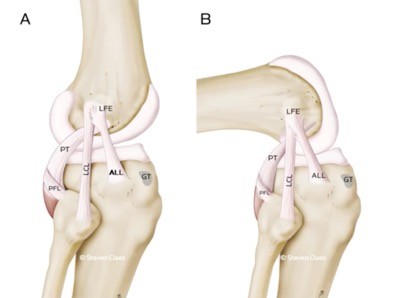EXAMPLEDESCRIPTION
Meniscus It is a fibrocartilage structure inside the knee joint which articulates between the femoral condyle and tibial plateau. There are two menisci in the knee - medial and lateral. From the top view, they are semilunar in shape. The medial meniscus looks like the letter “C” and the lateral meniscus, the letter “U”. Their...
Dr Quang Dao Information for orthopaedic surgeons Some patients still report rotatory instability following well performed anterior cruciate ligament reconstructions. This may be due to neglected concomitant injuries to the anterolateral structures of the knee. In the last two decades there have been much research to provide anatomical and biomechanical data about these...
Dr Quang Dao Information for orthopaedic surgeons (ACL Anatomy) The anterior cruciate ligament (ACL) is composed of collagen fibres that connects the tibia to the femur. Currently there are two popular theories to describe the anatomy of the ACL. They are the Double Bundle Theory and the Ribbon Theory. The Double Bundle Theory The...
Dr Quang Dao Discoid meniscus is a congenital variant of the meniscus which can affect its size, shape and stability. Most often, it affects the lateral meniscus. Incidence It is a frequent finding in the Asian population with an incidence of up to 20%. In Caucasians, the incidence is 3-5%. It is slightly more common...
Anterior Cruciate Ligament Reconstruction in Children (information for Health Providers) Dr. Quang Dao Introduction Intra-substance tears of the anterior cruciate ligament (ACL) in children were rarely reported in the past. Historically, most ACL injuries involved an avulsion of the tibialeminence at the site of the tibial ACL insertion. However , mid-substance ACL injuries in children...
The anterior cruciate ligament (ACL) is one of the major ligaments of the knee. It sits deep inside the knee. It is made of collagen fibres and acts like a rope connecting the tibia (shin bone) to the femur (thigh bone). It guides the knee in its normal motion. More importantly it stabilises the knee....
Patellar Dislocation Patellar dislocation occurs when there is total loss of contact between the patellar and the femoral groove. Patellar subluxation is defined as partial loss of contact between the patellar and femoral groove. Both these disorders belong to the spectrum known as patellofemoral instability (PFI). The incidence of PFI in children and adolescents is...






